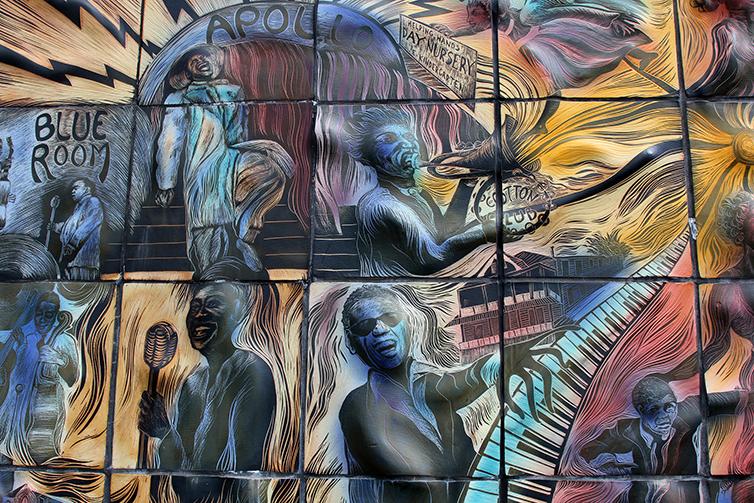Video of Perry Harvey Park by Nicole Abbett

View PDF of Perry Harvey Sr. Park Map
History of the Area: The Scrub and Central Avenue
The Scrub, once Tampa’s oldest and largest African American neighborhood, traces its history to just after the Civil War,when newly-freed slaves built homes in a scrub palmetto thicket outside of the Town of Tampa. The heart of The Scrub was the Central Avenue Business District.
Between 1900 and 1930, the black population of Tampa quadrupled (from 4,382 to 21,531), and the number of African American businesses on and around Central Avenue rose to over 200. By the 1930s, Central Avenue offered everything necessary for daily life, including a thriving music scene as a stop on the Chitlin' Circuit. According to National Public Radio, the Chitlin' Circuit was a “group of performance venues located mostly in the South that were safe and acceptable places for African-American musicians and entertainers to perform during Jim Crow.”
Construction of I-4 and the urban renewal projects in the 1960s disrupted business and dislocated customers. The district itself escaped demolition at the time, but it could not escape the 1967 riots that swept the country. The last business closed on Central Avenue in 1974 and the street south of I-275 has completely vanished. Only a handful of buildings remain on nearby streets. Special thank you to our partner on this project, the Tampa Bay History Center.
The artwork at Perry Harvey Park is unique and contextual. Four major artworks by four artists work together in an attempt to tell the full and complex story of the abundant contributions of the African American community and Historic Central Avenue. This artwork was made possible in part by the National Endowment for the Arts. Download "From The Scrub to the Twist" Newspaper In Education produced by the Tampa Bay Times for more information on the history of the area! (30 MB PDF)
Additionally, download the brochure of the park and take it with you!"
Gateway Sculptures by artist James Simon
Photos by Amy Martz
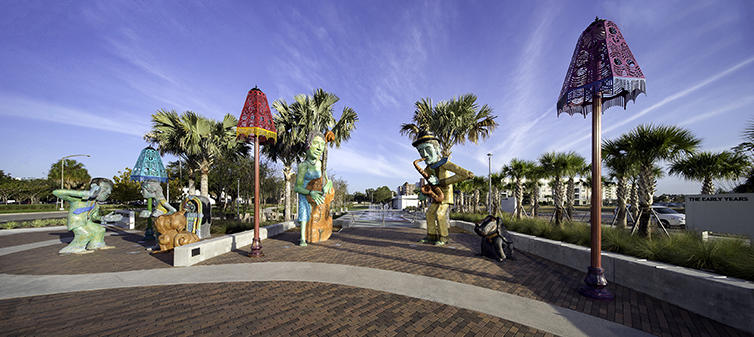
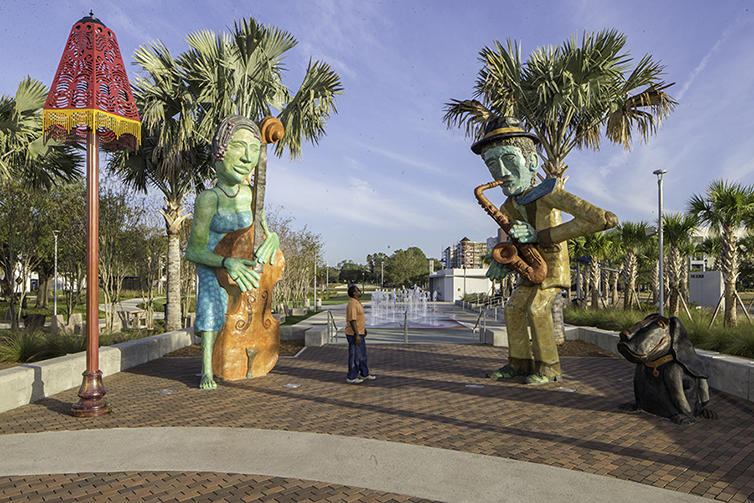
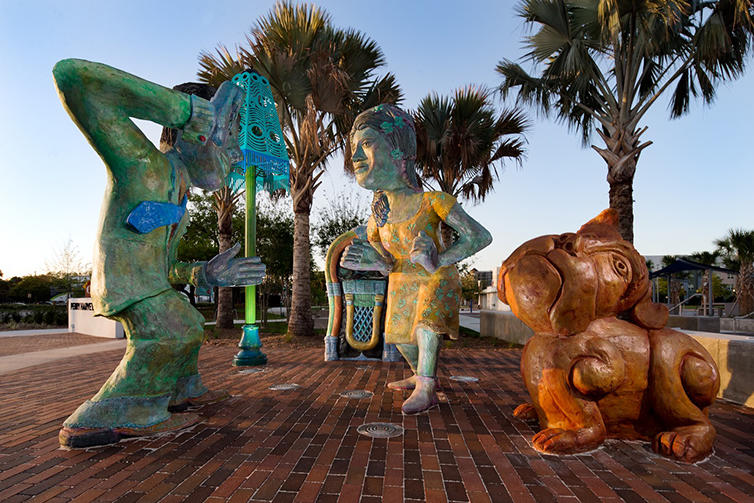
Providing a welcoming entryway into Perry Harvey, Sr. Park, James Simon’s sculptures of musicians, dancers, and a jukebox help highlight the importance of music to the history and culture of the historic Central Avenue Business District. The spirit of music and dance permeates the air around the artwork. Duplicating a familiar yet bygone scene, the dancers enjoy the music flowing from the jukebox while the “live” musicians play “next door”; sights and sounds that were once seen and heard along Central Avenue every night.
These sculptures, that range from 12’ to 16’ high, were first created in clay and then cast in a fiber reinforced concrete. The antique-style light poles and special shades complement the musicians and help to create a unique atmosphere.
History Walk LIFETILES by Rufus Butler Seder
History is the art in Rufus Seder’s LIFETILES work on the history of The Scrub and Central Avenue. The eight murals created from Seder’s hand cast optical tiles called LIFETILES feature historic photographs of The Scrub and Central Avenue as the basis of the artwork, and Seder makes these individual moments come alive to tell various stories of the past. The LIFETILES installation explores a variety of themes: the Early Years, The Scrub, Central Avenue Business Leaders, Central Avenue Timeline, Central Avenue Heyday, Social and Religious Life, Civil Rights and Health and Education. The timeline wall puts these into context, while the Hey Day wall shows the importance of local and national music acts in Central Avenue’s history.
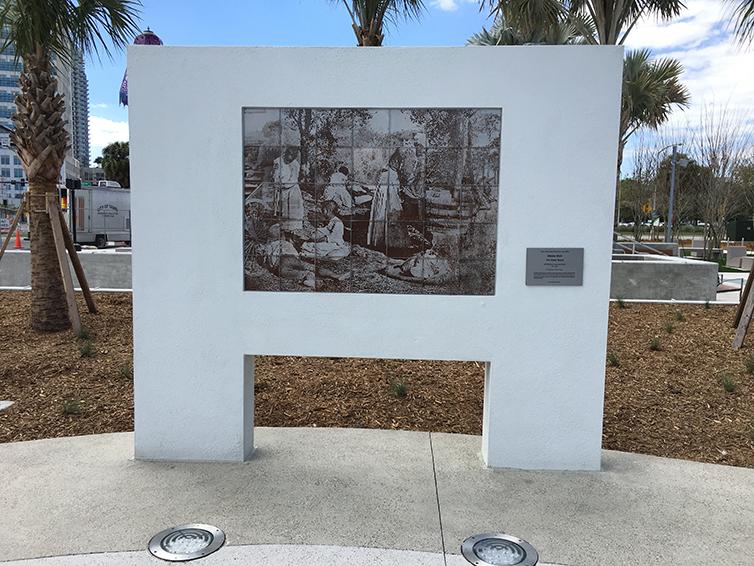
The Early Years - Though Tampa’s African and American history is centuries old, the history of The Scrub and Central Ave. traces its origins to the end of the Civil War. The community that took root on this site and in the surrounding area was founded by recently freed slaves, some from the immediate area and others from the greater Tampa Bay region.
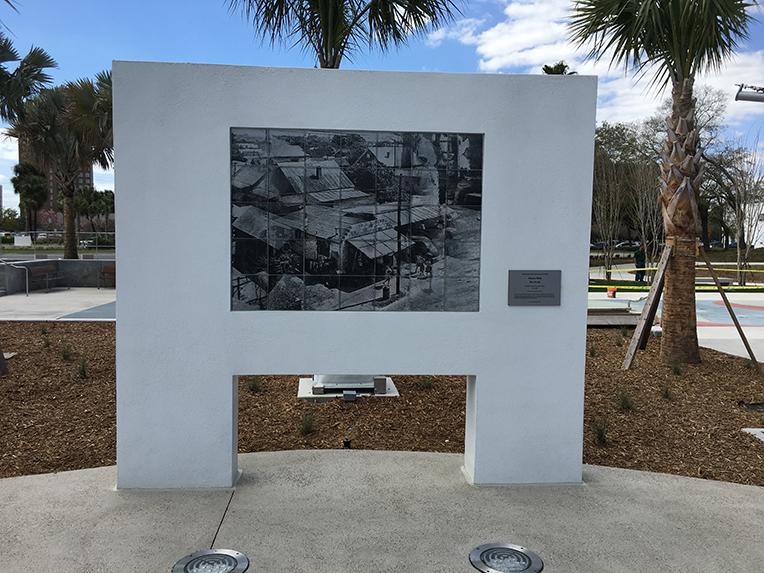
The Scrub - In the shadow of downtown Tampa, nestled between the growing business center and the cigar-making enclave of Ybor City, stood The Scrub. Named for the scrub palmetto that once dominated the landscape here, by the late 1800s The Scrub was home to the majority of Tampa’s African American population
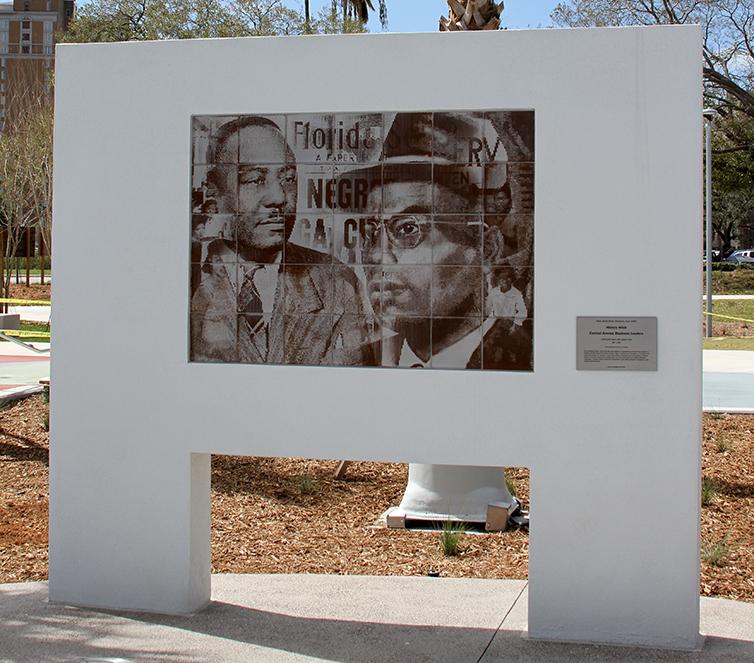
Central Avenue Business Leaders - The restricted access under the laws and customs of segregation prompted the growth of a business district along The Scrub’s western edge. Leaders soon emerged to help guide and foster generations of residents. From Clara Alston’s Helping Hands Day Nursery to Moses White’s and Watts Sanderson’s restaurants (Palmetto Dinette and Blue Room respectively) and other businesses to C. Blythe Andrews’ newspaper (The Florida Sentinel), Tampa’s African American community could obtain whatever it needed on and around Central Avenue.
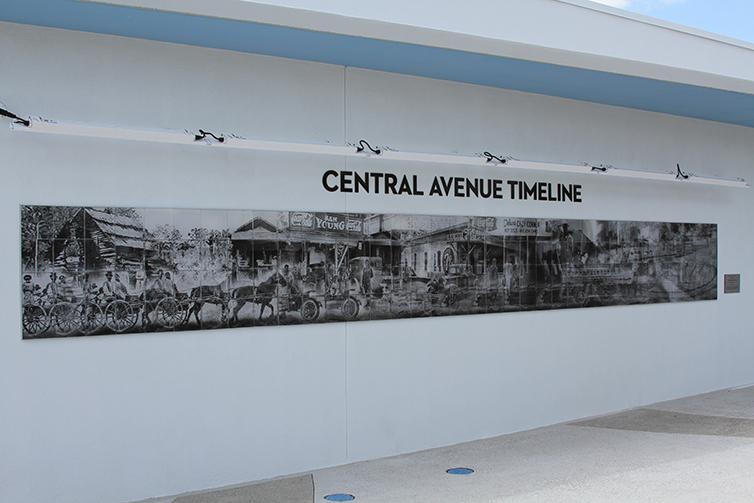
Central Ave. Timeline - A feeling of time travel is created as one walks by this mural. Images tell a timeline story from the early days of palmetto fields and The Scrub through the era of a booming business district and Civil Rights strife to the present day. Viewers will see the image of a vehicle as it rolls alongside them, morphing before their eyes from a horse drawn wagon carrying African American settlers, before transforming into an early model truck, then a 50’s style luxury auto, etc., ending with a graceful Bro Bowl skateboarder sweeping through the bowl.
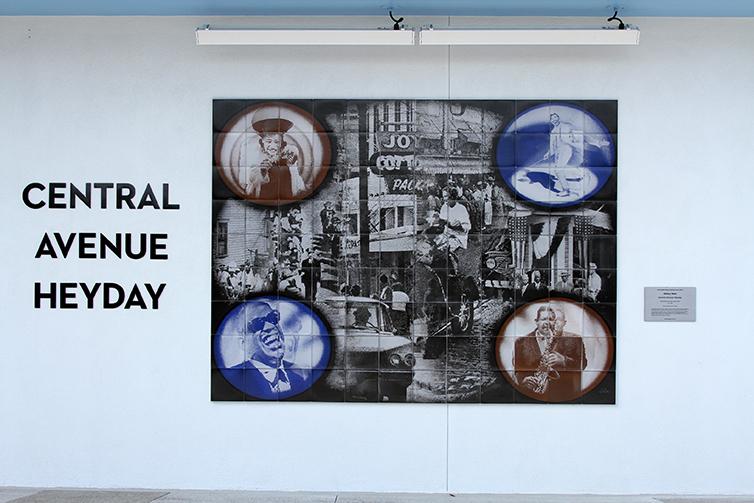
Central Ave. Heyday - At its peak between the early 1920s and late 1950s, Central Avenue was home to businesses large and small, including restaurants, professional offices, hotels, movie theatres, and night clubs. The music and entertainment scene on Central fostered local musicians and hosted national acts. Cab Calloway and Ella Fitzgerald came through on the “Chitlin Circuit”, while Ray Charles and Cannonball Adderley started their careers on Central.
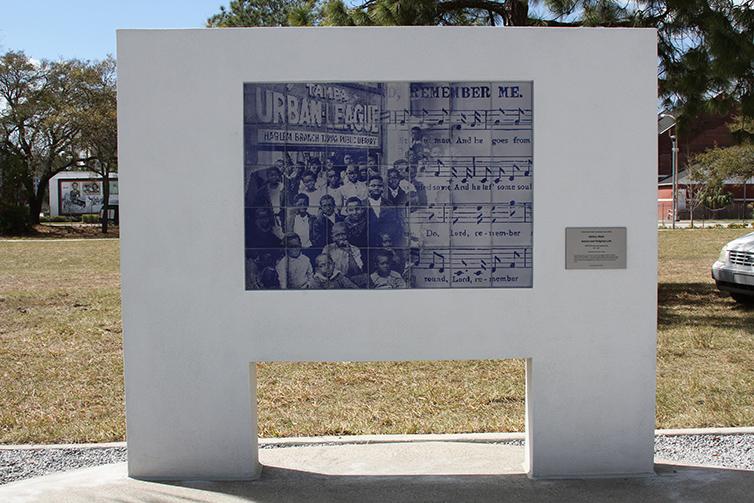
Social and Religious Life - The Central Ave. area was also the social and religious center for Tampa’s African American residents. That support system helped to ease the burden of the dominant Jim Crow Laws and helped to facilitate the removal of those same laws. Several historic church buildings remain today as reminders of that important legacy.
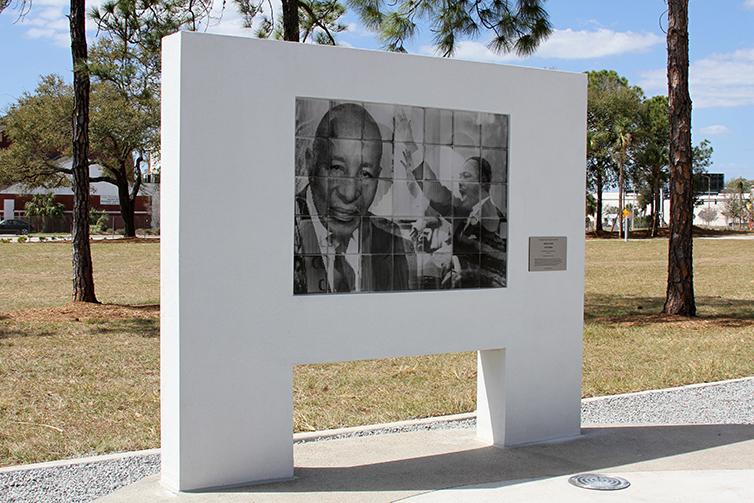
Civil Rights - By the 1950s, separate but equal was no longer acceptable to many African Americans, both across the city and around the country. In Tampa, the Civil Rights movement’s leadership included Reverend A. Leon Lowry and Helen Saunders, who worked with others in the community to bring Martin Luther King, Jr. to Tampa in 1961. Downtown lunch counter sit-ins, a hallmark of the movement, were planned in the churches and the NAACP office near Central Avenue.

Health and Education - An educated and healthy population is vital for the survival and success of any community, and many people played a role in insuring both for the residents of The Scrub. Blanche Armwood and Christina Meacham were unparalleled leaders in education. St. Peter Claver provided the spiritual inspiration for the school that shared his name,and Clara Frye helped to bring medical care to those barred from the city’s facilities.
Perry Harvey, Sr. Bronze Statue by artist Joel Randell
Photo by Amy Martz
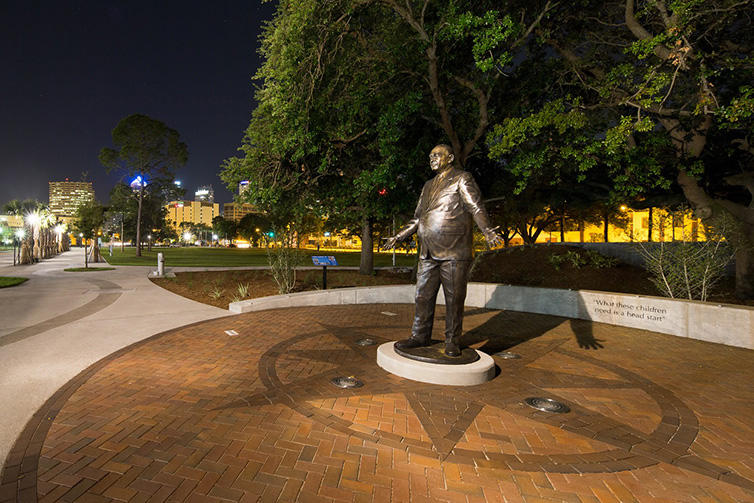
Perry Harvey, Sr. had a large impact on the lives of Tampa’s African American community. He was a founding member of the Longshoreman’s Union Local #1402, and served as its President from 1937 until just prior to his death in 1972.
Among his many accomplishments, he brought better wages, benefits, and improved working conditions to Tampa’s predominantly black dock workers. He helped create a black middle class in Tampa by providing jobs for those who sought employment, encouraged workers to save their money for family matters. Mr. Harvey helped create the first black-owned apartment building and plaza, which included a bank, supermarket, restaurant and other businesses. He was a leader by example, and was influential in Tampa’s Civil Rights movement. When appointed by Florida Governor LeRoy Collins to serve on the state’s bi-racial committee, he helped to desegregate the county’s school system.
Mr. Harvey was considered “a man of wisdom”, and encouraged others to better themselves and their families by working hard and keeping their minds busy. He sought educational opportunities for all children in the community, recommending children be given a head start at an early age. The resulting national Head Start Program is attributed to Perry’s vision and foresight.
Through photos of Mr. Harvey and interviews with his daughters, artist Joel Randell created this 8’ tall bronze sculpture that memorializes Mr. Harvey’s demeanor.
Leaders’ Row by Mike Parker
Photos by Amy Martz
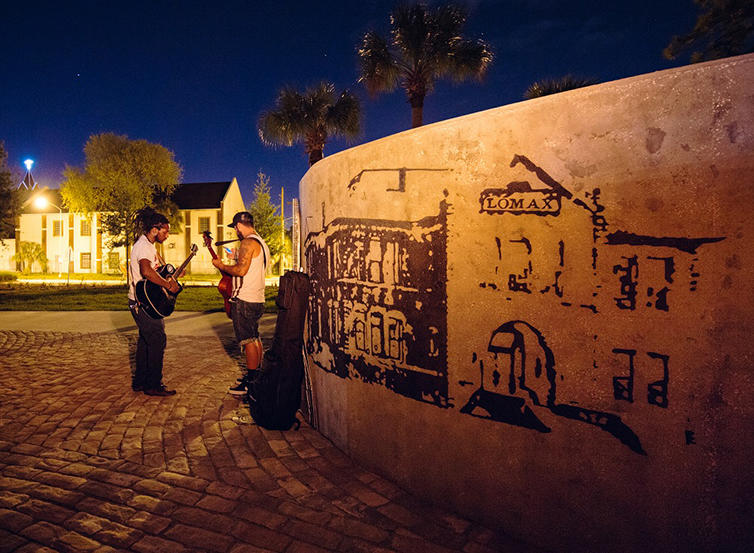
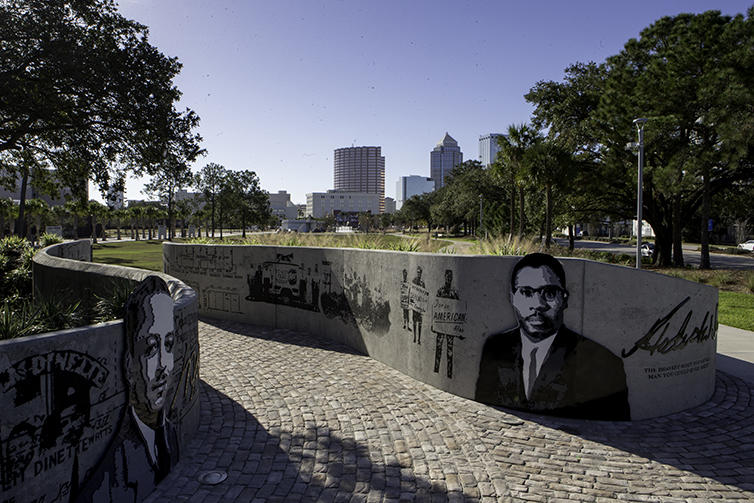
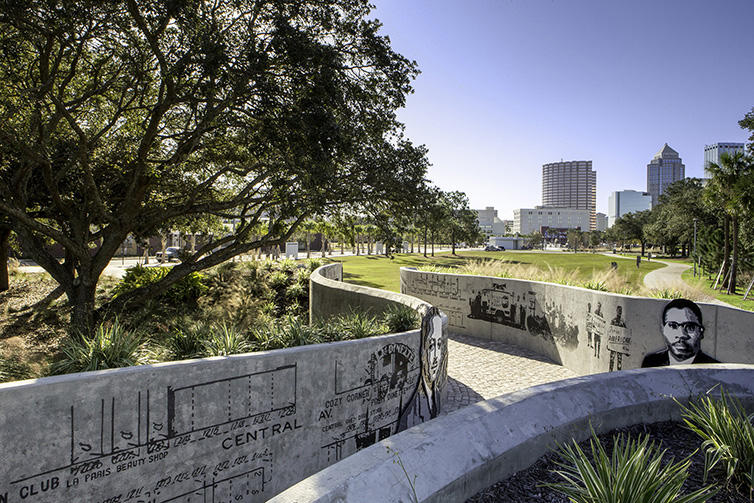
Leadership takes on many forms. Some are forceful and dominant, while others work behind the scenes and offer quiet support and encouragement. Regardless of style, the substance is the same. Motivating, prodding, assisting, nurturing, and even financing the dreams and aspirations of single individuals and whole communities, the men and women featured here provided both a bedrock foundation to build upon and boundless success to strive toward. Each one left their mark on the city and on the lives of those they inspired. Earth walls, sandblasted and stained concrete, hand plasma cut aluminum tell the story of the most influential individuals in the community through images and a Sanborn map. Representations on the wall include: Georgette Gardner, Henry Joyner, Christina Meacham, Moses White, Robert Saunders, Lee Davis, and Garfield Rogers
Timeline Pavers
A ribbon of concrete connects fourteen large, inset pavers that tell the chronological story of The Scrub and Central Avenue. Starting with the creation of The Scrub immediately following the Civil War and moving through its growth and the growth of Central Avenue, stories of culture, commerce, religion, and recreation guide visitors through the park and the neighborhood’s history.
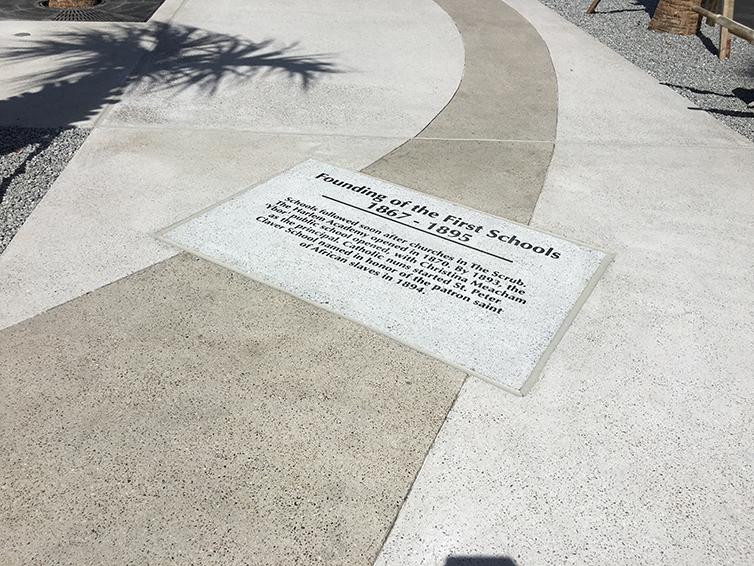

Clay Tile Murals at The Trio
Art and history are not confined to the boundaries of Perry Harvey Sr., Park. To the east of the park is the residential community called Encore!, a planned mixed use development built by the Tampa Housing Authority. Natalie Blake’s three large ceramic tile murals tell the story of Tampa’s African American community from the city’s pioneering days to the rise and decline of The Scrub and Central Avenue through the construction of the ENCORE!. Blake’s dynamic use of symbolism and nature – the sun, river, and trees – and real scenes like churches, musicians, and Central Avenue – combine to tell the rich story of a place and its people. Download the education packet on Natalie Blake's murals!
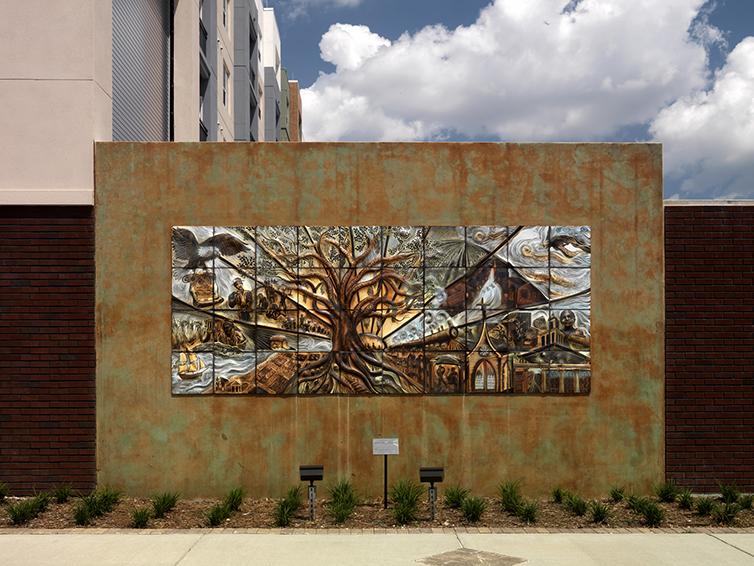
The first panel depicts early African American life in and around Tampa. Starting with the pre-Civil War days, when the vast majority of the black population was enslaved, the panel moves on to Emancipation, the beginning of self-sufficient African American communities in the late 19th century, and concludes with the establishment of the Central Avenue business district in the early 20th century.

This second panel has as its focal point the sun at center left of the mural. Radiating outwards are many of the accomplishments and inspirations of Tampa’s African American community, as well as, , people in service of that community. Highlights include a vibrant Central Avenue, depicted in its mid- 20th century heyday with imagery of its rich music scene, stylized depiction of the Central Avenue businesses, as well as an African American man casting a ballot.

In the final, or southernmost panel, the rays of the sun are represented by banners emanating from and powered by the sun’s energy. The banners symbolize the weaving together of new life into the future. Each banner supports an aspect of the community that has held together some semblance of the dissipated energies of Central Avenue. The unique and incredibly important components of this disjointed place are important to preserve and document.
